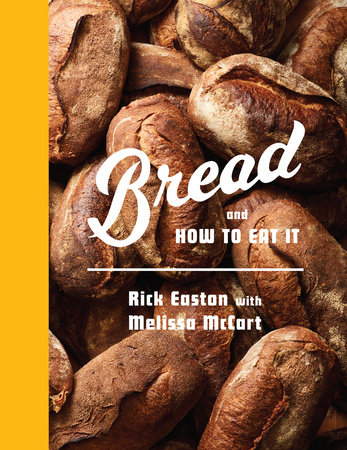Bread
This is not intended to be a baking book. I had originally planned to not have any bread recipes at all. Having started as a home baker myself, I think home baking is unnecessarily difficult and incredibly inefficient. But no publisher wants to touch a book about bread without bread recipes in it, so I’ve provided a few. I’m not trying to present signature breads here—many great books have already been written on the topic. Still, while I don’t provide very much to build on what’s already out there, I’ve offered some basic ideas to help you further understand the process of baking and what it involves.
One more note: I’ve kept the bread recipes in grams as opposed to standard measurement because it’s more precise and I think many bakers before me have made the case of why metric measurement is so important in bread baking. Outside of the baking chapter, I have both grams and standard measurement since those recipes are more flexible and in part so you can keep the ratios that I’m suggesting.
Starter
When it comes to baking bread, sure, you can follow my recipe or anyone else’s. The recipe is beside the point. What has value is that you learn your starter. You learn how to care for it. You learn the discipline and the rigidity it requires to get it on a predictable schedule. You learn what it needs and how to take care of those needs.
Your starter will become stronger the more you feed it over time. Using the method below, the starter will be ready in seven to ten days, but it might not be very consistent or predictable until you have fed it for a longer period of time. Your second or third loaf made with this starter will likely turn out better than the first—because your starter will be healthier and more stable by then.
I do not suggest refrigerating your starter at any point, especially when you’re trying to establish it—otherwise, the yeast will get too sluggish. In fact, I don’t recommend refrigerating it ever. But if you have to—you’re going to be away for an extended period of time and you want to retard the growth—wait until it has at least tripled in size (after several days) before you do. (See below for exact directions on refrigerating.)
What you’ll need
A kitchen scale
A clean, clear container that can hold up to 4 cups of liquid
A clean dish towel
A space that maintains 78°–82°F (see note below)
A room thermometer that’s more exact than a thermostat or probe thermometer
Ingredients
50 grams raisins
1500–2000 grams spring water (100 grams per 15–20 feedings, plus an additional 100 grams per feeding)
100 grams stone-milled rye flour or stone-milled whole-wheat flour
1500–2000 grams strong white bread flour—at least 12 percent protein (100 grams per 15–20 feedings)
Instructions
Note: The key here is temperature. Yeasts favor a temperature from 78° to 82°F; 80°–82°F is optimal. You’ll need to set up a place in your house that will allow you to keep the starter at that temperature. (There are all kinds of ways you can do this: inside your oven with the light on, for example, or in your microwave.) It is important to invest in both room and probe thermometers to make sure the right temperature is maintained at all times.
To make the starter: Place the raisins in the container, along with 200 grams of spring water heated to 78°–80°F. Keep the mixture loosely covered with the dish towel for 24 hours, kept between the high 70s and 80°F. Generally, once you have made bread with the starter a few times, you will be able to use tap water. But when you’re getting a new culture established, you don’t want to introduce anything that’s going to make it harder to establish a culture, such as fluoride or chlorine.
After 24 hours, strain out and discard the raisins, reserving the liquid. Mix 100 grams of that infused water with the stone-milled rye flour or stone-milled whole-wheat flour. (Rye tends to be a little more active and makes the process go faster.) Keep that mixture covered loosely with a clean dish towel for 24 to 72 hours at 78°–80°F.
During that time, you should notice a slight increase in volume and some bubbles in the mass. This means it’s ready for the next step; it can happen in as little as 24 hours and as long as 72. (The last time I did it, it was ready in 36 hours.)
If the mass does nothing within 72 hours, throw it away and start over.
After you’ve seen the slight increase in volume and bubbles on the surface, scrape off the surface if it’s dry. Mix 100 grams of the remaining liquid with 100 grams of white bread flour and 100 grams of 80°F spring water. Put this mixture back in the 78°–80°F spot for another 24 hours. At this point you should be able to detect real activity, as it rises. Once every 24 hours, feed it with 100 grams of bread flour and 100 grams of spring water, stirring it gently with a spoon or your clean fingers to mix, as long as it’s rising and has activity.
After the third day, if the starter is rising consistently, feed it at shorter intervals: every 12 hours for two successive feedings. What you’re looking for is the starter to triple in volume. It should be active and frothy.
Your goal is to train your starter to reach that peak within 3 or 4 hours. After the two 12-hour feedings, you should feed it every 8 hours until you get to a point that you’re feeding it every 3 to 4 hours. At that point, you can begin using it to make bread. It’s not about the time it takes; your starter will have more than tripled in volume, so you’ll have to feed it more frequently.
If you plan to use the starter soon (or daily), keep it at that warm temperature and feed it two or three times a week. If you are going to use it later, cover and store the remaining starter in the refrigerator, feeding it once a week. To reactivate it, return it to the 78°–82°F environment and feed it two or three times before you use it.
Bread for home bakers
Makes 2 loaves, just under 2 pounds each
As I have expressed, I am not the biggest fan of home baking. But I’ve done enough of it to be able to offer some pointers and direction if you want to pursue it and it brings you pleasure and joy—or if you are just interested in better understanding the basic mechanics of bread making. If you are looking for tricks to make great bread at home, those books have been written and I don’t have much to add to the subject.
To begin with, all flours are different, sometimes even from batch to batch from the same mill. Certainly, it is different from mill to mill, especially if you are sourcing flour from small local producers. I can offer a set of basic parameters and tell you to find flour with a certain protein level—but be careful. Protein percentages only paint a partial picture and don’t really give any indication of gluten quality; some of the favorite breads I have made were with flours that had only 9 or 10 percent protein, and I have made plenty of terrible bread with flours coming in at 13 to 14 percent protein.
I can also tell you to make sure that the “falling number” of the wheat used to mill the flour is above 300. The falling number indicates the level of enzymatic activity. The lower the number, the higher the enzymatic activity which indicates sprouting damage to the wheat and lower quality flour. This is a more common problem for wheat producers in wetter parts of the country and generally a good thing to know.
But these are just numbers and technical details, and they can’t take the place of forming your own relationship with the flour and, by extension, a miller. Great bakers rely on a lot of sensory cues that can help them make adjustments in the process as necessary.
One difficulty in bread recipes is that your starter will be different from mine. Even if I gave you some of my own, the yeast populations and various microflora in your home would change the starter over time. In addition to forming a relationship with flour, you need to develop a relationship with your starter. You should understand its cycles, rhythms, and behavior, keep it on a consistent feeding schedule, and learn to understand what it needs, when it needs it, and how it performs best.
Environment is another huge factor. Commercial bakeries have large proofers and temperature-controlled rooms to keep the fermentation and maturation of the dough on a predictable schedule. People suggest all manner of workarounds to create some semblance of temperature control for the home baker. You could put the bread in the oven with the light on and the temperature off. Maybe your pilot light will be enough to provide consistent warmth. An electric aquarium heater in a cooler with some rigged-up control system might work. Or you could place a space heater in a closet and set it on very low, or buy a small proofer designed for home bakers. All of this seems impractical and expensive to me, and it’s a lot of effort. But if you are thoroughly committed and handy—go for it: rig something up.
Part of the problem here, however, is the mass effect. A large amount of dough holds its temperature for a much longer period. As a result, it tends to ferment more thoroughly and evenly than smaller amounts, which will quickly equalize to room temperature. Since it is impractical to make large amounts of dough in a home setting, I suggest just going with the ambient conditions and adapting your process to them.
Consistency in temperature helps you predict a general time line for your bread. Since the actual temperature of the room is often different from the setting on your house thermostat, you should invest in some room thermometers so you can keep accurate track.
If, as an example, we assume that the room where you are storing your flour and baking is between 68° and 76°F, I would suggest using water right around the same temperature and adjusting the amount of starter used in your bread. If the air is closer to 68°F, I recommend using 5–6 percent (relative to the amount of flour) active starter when you mix your bread and decreasing that number as the temperature increases.
If the temperature drops or increases outside of that range, use cooler or warmer water to adjust the temperature of your dough. The goal is to have the temperature of the dough match the surrounding air.
If you want to learn to make bread, and especially if you want to make good bread, the best advice I can give is to make a lot of bad bread. And I mean a lot. I still do it pretty often myself. It isn’t a fast method, but it is the best way to figure out what things are supposed to look like, feel like, smell like, and taste like at every step in the process.
To even start down that path, you have to develop a clear idea of what you define as good bread. Understand what you are trying to attain and then figure out how to get there.
This recipe is not for beginners. If it’s your first time baking bread, I suggest you try the excellent no-knead recipe from Jim Lahey, widely available online. Try it with a bunch of different flours—particularly some you might order from, say, Community Grains (see Resources on page 000), or others that you pick up at a farmers’ market. Try that recipe with a blend of whole-wheat and white flours. And then move on to the more involved recipe from Chad Robertson’s book Tartine and do the same thing. Slight variations in temperature, humidity, and the flour you’re using will make a difference in timing and the performance of the dough.
This is how I bake bread. And it truly can vary according to the weather—or even whether my oven has been on all day and makes the room hotter. I’m not going to simplify it for you: I want to emphasize here that you are not making an industrialized product with mass-produced ingredients. Bread baking is like taking care of a child—or at the very least a small pet. You have to be committed and pay attention to details. And you have to be okay with the fact that details are going to vary. The only way they’re not is if you use a simplified or dumbed-down recipe, commercial yeast, and mass-produced ingredients.
That said, mine is a lot like other bread recipes that require starters. I’m not reinventing the wheel here.
What you’ll need
A kitchen scale
A digital thermometer
A straight-sided, lightly oiled container, preferably with a lid, where your dough will rise
One or two Dutch ovens
A bench (dough) scraper
Two proofing baskets (or two dish towels in two bowls or colanders)
Ingredients
800 grams water (or more; see note below)
1000 grams bread flour, plus more for the counter
200 grams Starter (fully ripe; see page 000)
25 grams salt
Instructions
Note: The temperature of your water is crucial. Calculate the correct temperature by determining the temperature of your room and the temperature of your starter. You want a final dough temperature of about 78°F. Multiply 78 by 4, which gives you a base temperature of 312°F. Subtract the temperature of the flour and the temperature of the starter. The number you arrive at should give you a good ballpark of what your water temperature should be. Friction is negligible when you’re mixing by hand. An accurate thermometer is essential.
Mix 700 grams of the water with all of the flour in a mixing bowl large enough to hold everything with some room, until no dry flour remains. Cover the bowl with plastic wrap and transfer to a warm place (78°–82°F) to rest for 20 minutes or so. After this period of rest, mix in your starter with a splash of the remaining water. Use your fingers to work everything into a homogeneous mass. Cover and let rest for another 10 minutes or so, back in that warm place. At this point, mix in the salt with an additional splash of the reserved water until completely dissolved. Rest, covered, back in the warm spot, for another 15 minutes.
After 15 minutes, grab a corner of the dough, stretch it out, and fold it into the center of the mass. Repeat this, rotating the bowl until the dough feels taut and gives resistance. Flip the dough over, leaving the smooth side up, cover, and rest in the warm space for another 15 minutes.
Copyright © 2023 by Rick Easton. All rights reserved. No part of this excerpt may be reproduced or reprinted without permission in writing from the publisher.







